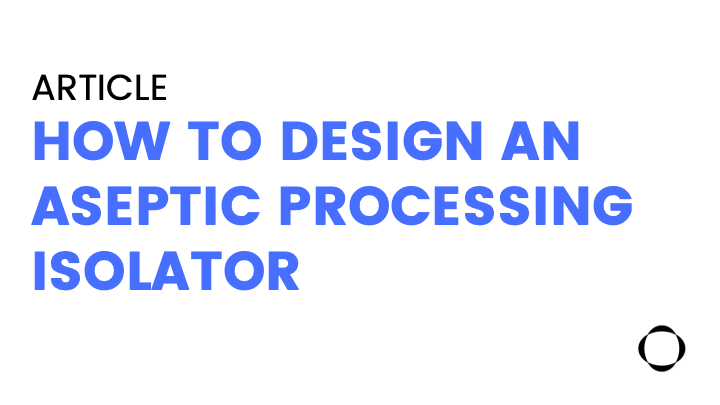This article focuses on using the 6M tool as a support of the design of an aseptic isolator. The objective is to provide a generic assessment of the machine requirements to ensure that all key aspects are taken into account, and common mistakes are avoided. Thus answering the question: How to design an aseptic processing isolator using 6M?
Ishikawa fishbone diagram and 6M tool are very well-known methods that quality departments often use to investigate an event’s root cause. In manufacturing, we use these tools in case of process deviations, like a failed in-process test. Tools like these are very versatile, and you can adopt them in any department to investigate the source of an unexpected result. Ishikawa’s fishbone diagram is a cause/effect diagram that makes it suitable to analyze the logic of any process. If it is true that this tool is used to find the cause of an error, it is also true that it can be used positively as an error prevention tool.

1. Machine
The primary scope of an isolator is to create a contained, aseptic environment in which the process is protected and can be performed with virtually no risk of contamination. Therefore, the isolator needs to be mechanically integrated with the main machine responsible for the process. Moreover, in an aseptic filling line, the isolator will also be connected to an upstream machine and a downstream processing machine.
Besides mechanical integration, communication and integration of process automation between the machines are crucial for the process’s correct functioning.

Figure 2 – Schematic example of mechanical integration of machines in a sterile filling line.
The following points need to be considered to identify the specific isolator requirements in relation to the machine:
1. Compatibility of the encapsulated machine/s with isolator design
- Decontamination requirements (consider the presence of occluded/masked surfaces that can limit the sporicidal action of H2O2 vapor)
- Airflow requirements (consider the presence of parts that can disturb the linear airflow and create turbulence)
2. Type of filling machine to encapsulate
- Multiple products vs. campaigned dedicated (impact on changeover activity)
- Small batches vs. large batches (impact on the quantity of consumables inside the isolator and materials to bring in to sustain the process)
- Disposable/dedicated fill set vs. CIP/SIP (impact on parts to transfer inside the isolator)
3. Integration of additional machines and communication
- Pressure cascade implications between the machines
- Logic of sterilization/decontamination of the isolator and upstream machine
- Management of the sterile bit of the isolator
- Physical communication mouseholes and sealing gates between isolator and downstream machine (consider the choice of manual or automatic, active or passive mousehole)
4. Integration of machine interface
- Soft integration (every machine equipped with its HMI from the supplier)
- Hard integration (all the machines share the same HMI of the client)
5. Integration of smaller equipment
- Automatic environmental monitoring (particle counters, vacuum pumps)
- Glove integrity testers
- Decontamination units (location of vapor hydroxide peroxide generator)
- Material transfer units (if needed, consider the choice between integrated or detached from the main isolator)
Do not design the isolator to have the same footprint as the machine to encapsulate to contain the budget. Design errors can be much more expensive than having extra isolator space.
Do foresee some extra space around the machine to encapsulate so that it is possible to perform side activities like environmental monitoring in a compliant and safe way.
Method
An aseptic isolator’s additional primary role is to decontaminate the internal surfaces where the process takes place. Moreover, the isolator provides a laminar flow area to protect the processing area from particle contamination. These functions can be performed in multiple ways.

Figure 3 – Different method of air supply: technical area vs. cleanroom
The following points need to be considered to identify the specific isolator requirements in relation to methods:
1. Method of air supply
- Air taken from outside
- Air taken from a technical area (impact on the footprint in the technical area)
- Air taken from cleanroom
2. Method of decontamination
- Choice of the decontaminating agent (impact on process and materials)
- Choice of mobile system or integrated system
3. Method of material transfer
- Passive systems: Rapid Transfer Port (RTP) (impact on the process, for example, manual or automatic stopper supply)
- Active systems: Autoclaves, freeze dryers, sterilizing tunnels, disinfectant hatches, electron beam tunnels (significant impact on isolator mechanical integration and logic of pressure cascade)
Do not choose in a rigid way the stopper supply method. Retrofit of features can be disruptive and expensive.
Do onsider flexible choices that allow easy retrofit of beta stopper vessel in case of increase of volumes (RTP installed on removable panel).
Material
Like any pharmaceutical processing machine, it is crucial to specify requirements linked to construction material. Special attention is required as the isolator’s internal surfaces will come in contact with aggressive sporicidal agents.
The material that is processed inside the isolator can have a big impact on some isolator features.
Any production process needs new components to be fed and waste to be removed. Even if the isolator is a barrier technology, it needs to allow this passage of materials to sustain the process without impacting the sterility.

Figure 4 – Example of material transfer inside (via rapid transfer port 1) and outside the isolator (via rapid transfer port 2)
The following points need to be considered to identify the specific isolator requirements in relation to materials:
1. Material of construction requirements
- Compatibility with product
- Compatibility with cleaning agents, sporicidal agents
2. Product to process
- Solution or suspension (impact on the process, recirculation of suspension might require more connections in the isolator wall for product path)
- Toxic or non-toxic (significant impact on the isolator design, higher complexity in the product is toxic)
3. Product requirements
- Product oxidation (consider the need for nitrogen blanketing requirements)
- Product degradation (consider the light requirements, residues of sporicidal agent requirements)
4. Hanging material
- Design of hanging bars and hooks (impact on geometry and quantity of elements)
5. Materials to bring in
- Product path (consider the size, number of parts)
- Stoppers/Closures for vials/syringes (consider the size, quantity, flow properties)
- Consumables (consider the size the size, quantity, package)
6. Materials to bring out
- Product
- Waste (Consider the process: location, size, nature of waste produced and the step when this is produced)
Do not design the isolator if the properties of the product and materials to process are not known. Minor differences can lead to different design choices.
Do onsider the chemical/physical properties of the material to process. In case of automatic stopper supply, consider the material’s flow properties as this might have an influence on the inclination of the isolator wall where the RTP is installed.
Mother nature
The isolator air handling unit can provide a stable set point of pressure, temperature, and humidity. These attributes guarantee that the decontamination and production process can run effectively.

Figure 5 – Example of a pressure cascade between different machines in a freeze-dry filling line
The following points need to be considered to identify the specific isolator requirements in relation to mother nature:
1. Temperature requirements
- Decontamination process (consider the decontamination process requirements)
- High/Low surface temperatures (consider the impact to decontamination process)
2. Humidity requirements
- Decontamination process (consider the decontamination process requirements)
- Process temperature and dew point (essential to keep humidity low to avoid condensation, critical when filling cold products)
3. Pressure requirements
- Differential pressure with cleanroom
- Pressure cascade upstream/downstream machine
4. Environmental monitoring requirements
- Quantity of monitoring stations (consider the size of the isolator and critical areas)
- Position of monitoring stations (consider the size of the isolator and critical areas)
5. Environment-friendly design
- Catalytic converters to break down the H2O2 (impact on the length of the cycle, emissions)
- Recycle the air already conditioned (impact on energy consumption)
- Recycle the heat from black steam to condition the air (impact on energy consumption)
Do not design the isolator to have standard environmental requirements and then later determine that a low-temperature product needs to be processed. Condensation might be a showstopper for the process.
Do design the isolator’s environmental requirements around the specific product and the process. There is no generic rule for the isolator requirements.
Measurement
The isolator is very often delivered onsite separately from the machine that will be encapsulated in it. Accurate measurements are critical for a correct installation and alignment with the interfacing machines.
The isolators are equipped with many sensors that play an essential role in stabilizing and maintain the setpoint value of critical process parameters. The measurement’s ranges must be correctly identified according to the process requirements that are taking place inside the isolator.

Figure 6 – H2O2 concentration trend during decontamination of an isolator
The following points need to be considered to identify the specific isolator requirements in relation to measurement:
1. Isolator dimensions requirements
- Dimension of the enclosure (consider both the machine to be encapsulated and the process)
- Dimension and structure of the building (impact on design choices like air supply method)
- Move-in dimensions (impact on the installation onsite)
- Dimension of RTP ports (consider the process)
- Dimension of mouseholes (consider the product and the process)
2. Room layout requirements
3. Measurement requirements
- Accessibility features for measurement (impact on cycle validation, calibration activities)
4. Sensors
- Number of sensors
- Position of sensors
- Range of sensors
Do not design the isolator to have standard H2O2 low-level detection sensors (detecting 1ppm of peroxide residues) if later a sensitive biological product might be processed in the isolator (0,1 ppm detection required).
Do design the isolator sensors ranges around the specific product and the process. There is no generic rule for the isolator requirements.
Man
Even if the isolator’s machines are fully automated, manual intervention is still necessary to prepare/sustain the process and perform sampling operations. The isolator needs to be designed to allow easy, ergonomic, safe use by the operators. The more attention is put to satisfying these criteria, the more the process will be robust, compliant to aseptic practices, and carry less for the product.

Figure 7 – Example of Glove/Activity matrix, a tool used during mock-up study to assess machine stations requiring most attention
The following points need to be considered to identify the specific isolator requirements in relation to man:
1. Human handling reduction requirements (impact on process compliance)
- Automation of decontamination cycles
- Automation of material transfer operations
- Automation of material unwrapping
- Automation of environmental sampling
- Automation of cleaning (clean in place features)
- Automation of in-process control weighing (IPC robot)
- Human handling risk reduction (impact on machine wear and mechanical stress distribution)
2. Ergonomics requirements (impact on both usage and compliance)
- Number of gloves
- Number of doors
- Visibility
- Cleanability
3. Safety requirements
- Glove access restrictions (laser barrier, mechanical closing mechanisms with sensors)
- Laser barrier for decontamination
Do not wait for isolator FAT to assess the ergonomics and accessibility. It is too late at this stage. A correction at this stage has a detrimental impact on the project schedule and can be very costly.
Do put much effort first in the 3D model review and then in the isolator mockup exercise during the design phase. Involve a team of operators, aseptic handling experts, and maintenance technicians to assess ergonomics, cleanability, accessibility, mechanical stress distribution, sterility compliance, and adherence to good aseptic practices.
Conclusion
An exhaustive, specific, and correct User Specification Requirement document is vital for the machine. This document plays a key role in the validation cycle of the equipment.
Changes of scope and retrofitting implementations can be costly in terms of direct costs (modification works, purchase of new parts) and indirect costs (project delays, stop of production activities). Using the 6M method, it is possible to identify all the key factors that influence an isolator’s design.
The summary provided by this article can be used as a checklist during the creation of the User Requirement Specification document with the scope of achieving the Right First-Time design.
Blog by Daniele Vellei







